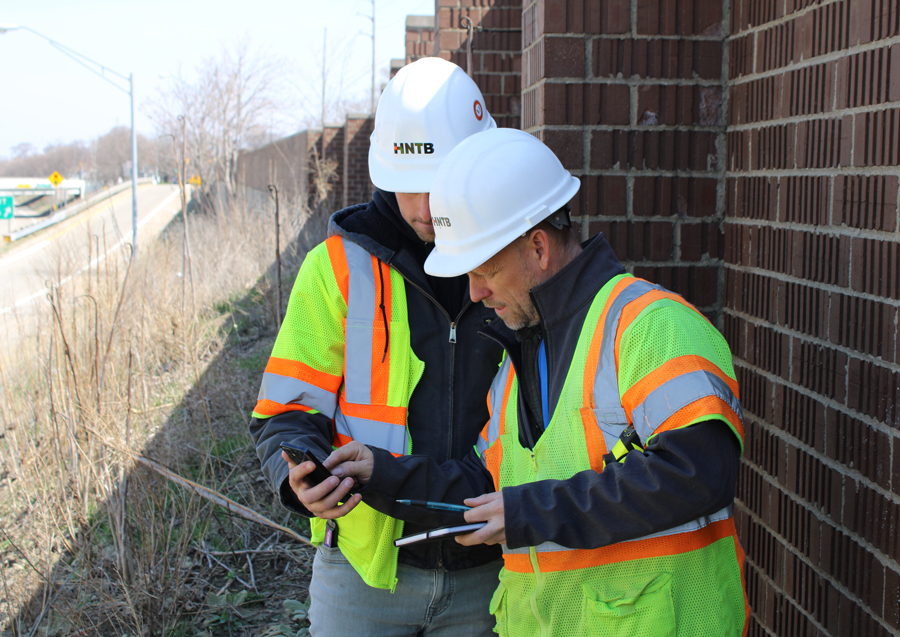A first-of-its-kind initiative for the state, the Michigan Department of Transportation’s Ancillary Structures Program is set to revolutionize the DOT’s future public roadway operations and maintenance.
An Overview
The program centers on the development and maintenance of an asset management system and database framework that will account for 70,000+ ancillary structures across the state. Previously, no singular database has been used to store or track information on these critical assets. As structures are inspected and inventoried into this new program, MDOT staff are now able to obtain and share real-time information on asset conditions, inspection progress, requests for action and more.
In turn, while inspections and data collection is still under way, the Ancillary Structures Program is already providing an efficient and reliable digital infrastructure solution that allows the department to proactively prepare and take action against safety issues or potentially costly fixes.
Program Management and HNTB’s Roles
As program management consultant, HNTB been working alongside MDOT since the project’s conception. Some of the firm’s services include:
- Data management, coordination and reporting
- Inspections, inventory and data collection
- Design standard reviews and updates
- Scoping and preliminary engineering
As part of HNTB’s larger role, and to ensure the successful delivery of the Ancillary Structures Program, the firm has provided these services and more to MDOT across a number of smaller initiatives.
Ensuring Success
Establishing Priority. The program set out to provide comprehensive asset management of 16 ancillary structure types critical to maintaining safe and efficient public roadway operations. But to capture of all 70,000+ assets throughout the state in an effective manner, HNTB and MDOT carefully considered the breadth of the inspection and cataloging process and determined which assets took priority.
The Manual. With priorities established and inspections ready to begin, HNTB also helped MDOT ensure statewide consistency within the documentation of ancillary structure conditions. The outcome of these efforts was the publication of Michigan Ancillary Structures Inspection Manual (MiASIM). This document provides information on inspection requirements and assessment of ancillary structures conditions to administrative, engineering and technical staff.
Inspection Training. While HNTB is taking an active role within ongoing inspections, the firm has also helped MDOT hire and train a reliable inspection staff. These efforts are supported by nine required, HNTB-developed custom, online modules that provide training for ancillary structures asset inspection processes. In addition, the firm developed and maintains an on-demand virtual training certification program for staff and inspectors, further establishing data collection consistency.
Geographic Information Systems. Digital infrastructure solutions are playing a key role throughout the program. The HNTB-developed asset management program uses a GIS-based application that allows staff to efficiently inspect, assess, and document the 70,000+ assets throughout the state of Michigan. Inspectors are able to upload photos to the asset management system. MDOT staff can then use these photos to assess issues remotely, allowing for more efficient and timely decision-making.
Drone Usage. HNTB has also implemented the use of unmanned aerial vehicles (UAV), or drones, to assist with inspections of communication towers and high-mast lighting towers that usually require special equipment on-site and certified inspectors to climb the asset. With the use of UAVs, inspections are completed more efficiently by capturing an in-depth, accurate assessment of the entire asset with high-resolution images and videos. This innovation improves safety and reduces the time required to complete an inspection and can be used to supplement any design tasks on these assets in the future.
A Solution Expanded
Expected to revolutionize MDOT’s roadway operations, the Michigan Ancillary Structures Program may help establish a new, improved model for asset management that can be implemented within transportation agencies across the country, helping them to proactively safeguard their assets and to continually provide safe, reliable transportation for the public.
Location: Michigan
Client: Michigan Department of Transportation
Services: Program management consultant; inspection, data collection and inventory services; data management, coordination and reporting services





